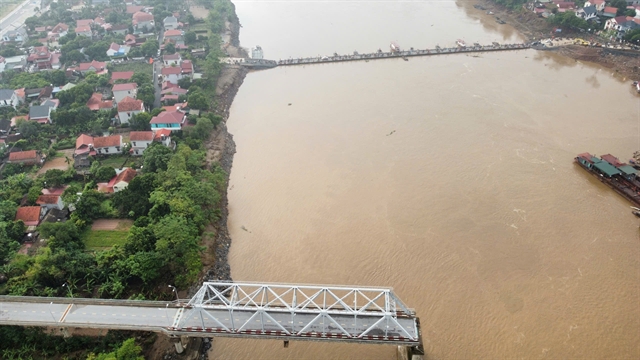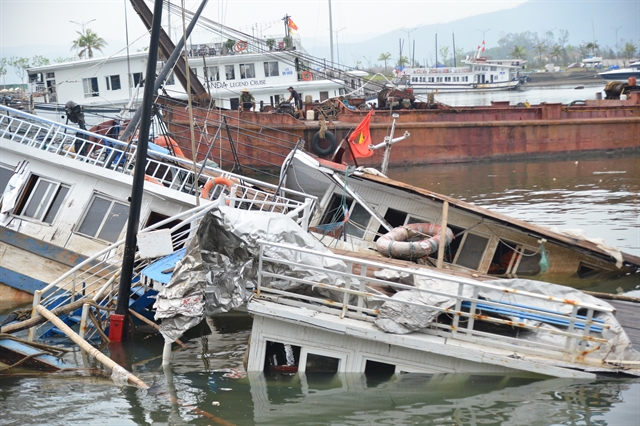 Economy
Economy


|
| Võ Trí Thành |
Typhoon Yagi has passed, yet its catastrophic impact on northern Việt Nam and the nation as a whole remains, leaving significant loss of life and property in its wake. As discussions unfold regarding the numerous challenges brought forth by the storm, it is imperative that we adopt a mindset of determination and reform to prevent the recurrence of such disasters in the future.
Making landfall in Quảng Ninh and Hải Phòng on September 7, Typhoon Yagi was the most powerful storm to hit the East Sea in the past 30 years. The storm resulted in the tragic deaths or disappearances of 344 persons, damage to over 280,000 homes and flooding of more than 112,000 residences. Additionally, an alarming 284,000 hectares of rice and 61,000 hectares of other crops were devastated.
As of September 28, the Government estimated economic losses at VNĐ81.5 trillion (US$3.3 billion), a rise of over VNĐ20 trillion from earlier assessments. Quảng Ninh experienced the most significant impact, with losses of VNĐ24.8 trillion, followed by Hải Phòng (VNĐ12.2 trillion), Hải Dương (VNĐ7.4 trillion) and Lào Cai (VNĐ6.6 trillion). Minister of Agriculture and Rural Development Lê Minh Hoan noted that agricultural losses alone reached VNĐ30.8 trillion, accounting for 38 per cent of the total damage.
As of September 25, Governor of the State Bank of Việt Nam Nguyễn Thị Hồng disclosed that outstanding loans impacted by Typhoon Yagi across all provinces and cities totalled VNĐ165 trillion, affecting over 94,000 customers. These losses are likely to result in a GDP reduction of more than 0.15 per cent for the nation in 2024, surpassing earlier forecasts.
In response to the disaster, the Government, civil organisations and businesses swiftly mobilised support. The Prime Minister ordered the provision of over 400 tonnes of rice worth VNĐ350 billion, as well as rescue and medical equipment for affected areas. The Việt Nam Fatherland Front and the Việt Nam Red Cross received nearly VNĐ1.8 trillion in donations, while international organisations contributed over $22 million.
The Ministry of Finance was tasked with implementing financial policies such as tax exemptions and reductions and easing land rent. The State Bank was instructed to create a credit programme with preferential interest rates and support debt restructuring for affected customers.
Currently, 32 credit institutions have announced support loan packages with interest rates 0.5 to 2 per cent lower than usual, totalling around VNĐ405 trillion. The monetary authority has urged financial institutions to assess damages and assist affected residents and businesses. The Social Policy Bank may receive an increased credit growth target for 2024-25, with the Prime Minister requesting debt restructuring and tax exemptions for affected groups until the end of 2025.
Local governments have proposed that the government provide VNĐ25 trillion for post-disaster recovery, with the Ministry of Agriculture and Rural Development requesting VNĐ10 trillion from the 2024 contingency budget.

|
| The Phong Châu floating bridge in Phú Thọ Province was opened to traffic on the morning of September 30, next to the collapsed bridge caused by Typhoon Yagi. Efforts to restore bridges, roads, electricity, and water supply are swiftly underway to ensure transportation. VNA/VNS Photo |
Ensuring effective support
The collective resolve to recover from the aftermath of the storm is commendable, but for maximum efficacy, certain issues must be addressed.
First, support must be substantial and prompt.
Reflecting on the two-year post-COVID recovery programme, which included a VNĐ340 trillion economic support package, many allocations remain unspent or unnecessary. By the end of 2023, only VNĐ1.22 trillion of the VNĐ40 trillion interest support programme had been disbursed, just 3.05 per cent. To effectively utilise funds for post-disaster recovery, it is crucial to streamline bureaucratic processes. Lessons from the pandemic emphasise the need for swift disbursement and decisive action from leaders at all levels.
Secondly, in terms of growth impacts, the Prime Minister is determined to achieve the national growth target of 7 per cent for 2024, despite the devastation. This ambitious goal poses significant challenges in the current context.
The Ministry of Planning and Investment forecasts that the disaster may hinder growth, projecting a 0.35 per cent decline in Q3 and a 0.22 per cent decline in Q4, leading to an annual GDP reduction of more than 0.15 per cent. While growth could reach between 6.8 and 7 per cent, many production sectors are expected to decline, with GRDP growth in regions such as Hải Phòng, Quảng Ninh, Thái Nguyên and Lào Cai likely to fall by over 0.5 per cent.

|
| The cruise ships in Quảng Ninh became scrap metal after the storm. Quảng Ninh experienced the most significant impact, with economic losses estimated at VNĐ24.8 trillion. VNA/VNS Photo |
In contrast, international organisations have issued more cautious predictions. The Asian Development Bank (ADB) maintains a 6 per cent growth forecast for 2024 despite global instability, while Singapore's UOB has lowered Việt Nam’s GDP forecast to 5.9 per cent due to storm-related damages. The full impact of Typhoon Yagi is expected to be clearer by the end of Q3 and into Q4 2024, particularly in northern regions, affecting production and infrastructure across various sectors. However, long-term fundamentals remain stable.
Experts have warned that Typhoon Yagi could disrupt export supply chains and domestic markets, resulting in lower-than-expected GDP growth. They urge ministries to accelerate public investment disbursement and disaster recovery efforts to stimulate economic revival. Despite challenges, there is confidence in Việt Nam’s growth potential, highlighting the need to maintain monetary policies that lower interest rates, along with debt restructuring and fiscal measures for tax relief for businesses and individuals.
Alongside promoting public investment, policies aimed at stimulating domestic consumption, boosting exports and attracting foreign direct investment are crucial to achieving high growth targets. Leadership must implement these policies with urgency, akin to the rapid completion of the 500kV power line project.
Thirdly, and most critically, the destruction wrought by the typhoon again underscores the urgent need to transition growth models, restructure the economy and enhance the resilience of the economy, all while aligning with significant global trends such as Industry 4.0, digitalisation, the green transformation and the circular economy.
However, despite repeated discussions on this issue, progress has lagged behind expectations.
Many goals in the economic restructuring programme, especially concerning labour productivity, remain unmet. Initiatives such as the digital transformation and the circular economy are progressing slowly; for instance, no action plans or "sandbox" for the circular economy have yet to be approved. While industrial zones attempt to manage wastewater, they lack standards from the Ministry of Natural Resources and Environment. Additionally, there is no classification of green projects within green credit initiatives, and despite the digital economy contributing 13-14 per cent of GDP, productivity growth has not met anticipated expectations.
Thus, in the current climate, it is essential to not only identify and approve strategic programmes but also to engage in specific actions, adopting a 'running and implementing' approach. We cannot afford to wait for legislation to be finalised before taking action. Many businesses in industrial zones have successfully undertaken self-initiated restructuring and digital transformation, achieving positive results. This is indicative of a harmonious blend of top-down and bottom-up strategies.
Regarding disaster prevention, Minister Lê Minh Hoan has highlighted the challenges in preparing for large-scale natural disasters. The risk of damage has not been communicated clearly, leading to complacency among the populace regarding the storm's destructive capacity. Nevertheless, this storm has imparted vital lessons regarding disaster management and response, particularly concerning the role of information technology and digital transformation in forecasting and warning systems.
In the long term, comprehensive measures must be implemented to enhance disaster resilience, including adjusting infrastructure standards and safeguarding flood escape routes. Areas at high risk of flash floods and landslides must be equipped with automatic warning systems and detailed disaster risk mapping.
As noted by the Prime Minister in a recent meeting, authorities are taking critical steps to ensure the safety of Thác Bà dam by diverting upstream floods and preparing to breach auxiliary dams while evacuating residents downstream. This highlights the importance of meticulous preparation for all potential disaster scenarios, including the worst case.
*Võ Trí Thành is former vice-president at the Central Institute for Economic Management (CIEM) and a member of the National Financial and Monetary Policy Advisory Council. With a doctorate in economics from Australian National University, Thành mainly undertakes research and provides consultation on issues related to macroeconomic policies, trade liberalisation and international economic integration. Other areas of interest include institutional reforms, financial systems and economics of development. He authors the Việt Nam News column Analyst’s Pick.




